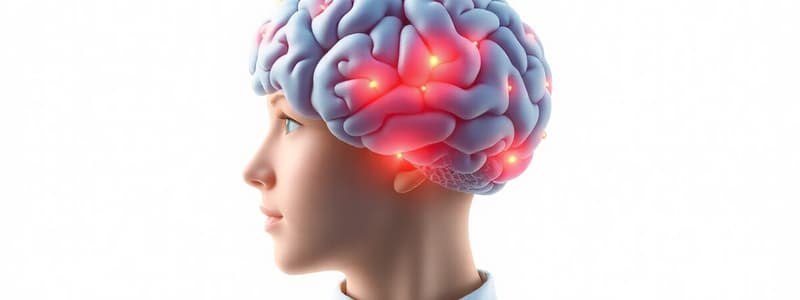Podcast
Questions and Answers
What does 'inhibition' primarily refer to in executive functions?
What does 'inhibition' primarily refer to in executive functions?
- The ability to learn new rules quickly
- Self-control and resisting distractions (correct)
- The ability to remember information
- The ability to use logic and reason
Which of the following best describes 'shifting' in the context of executive functions?
Which of the following best describes 'shifting' in the context of executive functions?
- Maintaining focus on a single task over time
- Resisting the urge to respond to distractions
- Adjusting to new demands and changing rules (correct)
- The ability to memorize information effectively
What does the marshmallow test primarily assess?
What does the marshmallow test primarily assess?
- Cool executive functions and mental processing speed
- Children's ability to memorize tasks
- Object permanence in young children
- Hot executive functions and self-control (correct)
What is the main explanation for infants displaying the A not B error?
What is the main explanation for infants displaying the A not B error?
Which of the following is NOT one of the three main components of executive functions?
Which of the following is NOT one of the three main components of executive functions?
How does the concept of preservation relate to executive functions in infants?
How does the concept of preservation relate to executive functions in infants?
What role does context play in the preservation reaching tasks for infants?
What role does context play in the preservation reaching tasks for infants?
Which of the following best defines executive functions?
Which of the following best defines executive functions?
Flashcards
Executive Functions
Executive Functions
Abilities enabling voluntary actions by setting goals, resisting distractions, and monitoring progress.
Inhibition (Executive Function)
Inhibition (Executive Function)
Self-control; resisting distraction, slowing or stopping a response.
Working Memory (Executive Function)
Working Memory (Executive Function)
Holding information in mind for use, like following an argument or doing math.
Shifting (Executive Function)
Shifting (Executive Function)
Signup and view all the flashcards
Preservation (Infancy)
Preservation (Infancy)
Signup and view all the flashcards
Marshmallow Test
Marshmallow Test
Signup and view all the flashcards
Hot Executive Functions
Hot Executive Functions
Signup and view all the flashcards
A-not-B Error
A-not-B Error
Signup and view all the flashcards
Study Notes
Executive Functions
- Executive functions are abilities enabling voluntary behavior, goal setting, distraction resistance, and progress monitoring.
- Three core components: inhibition, working memory, and shifting.
Inhibition
- Definition: Self-control, resisting distractions, suppressing responses.
- Examples: Slowing, stopping, or holding back known reactions.
Working Memory
- Definition: Holding information in mind for use.
- Examples: Following arguments, mental arithmetic, sentence comprehension.
Shifting
- Definition: Mental/cognitive flexibility, applying new rules, adapting to changing demands, altering perspectives.
- Examples: Adjusting to changed demands, adapting to new scenarios.
Hot vs. Cool Executive Functions
- Hot executive functions: Situations involving strong emotional responses (e.g., wanting to eat a marshmallow immediately).
- Cool executive functions: Situations with less emotional influence.
Marshmallow Test (Mischel & Mischel, 1987)
- Test of "hot" executive functions: measures children's ability to delay gratification.
Infant Executive Function Development
-
A-not-B error: Infants demonstrate "preservative reaching" (persisting with an inappropriate response).
-
Preservative Reaching is usually evident until 10 months of age.
-
Preservation: Persisting with a response despite inapplicability.
-
Piaget's theory: Infants lack object permanence (understanding objects exist even when out of sight).
-
Other research: Challenges Piaget's view; links object permanence failure to memory and action control deficits (i.e., executive functions).
-
Contextual influences on the A-not-B error: Theory of mind-type tasks, contexts, posture, and potential memory and spatial manipulation issues affect performance.
-
Multi-location search tasks and A-not-B: Demonstrate the impact of context on infancy executive functions by covering/uncovering different sheets and requiring the baby to manage the change in space by drawing on their memory.
Studying That Suits You
Use AI to generate personalized quizzes and flashcards to suit your learning preferences.





